Are you tired of dealing with expensive commercial cat litter or looking for more environmentally friendly options? If so, you're in for a treat. We've gathered 10 unique cat litter substitutes that may surprise you. From simple homemade solutions to ready-to-use alternatives, we've got you covered.
In this article, we'll explore a range of cat litter substitutes that can help you save money, reduce environmental impact, and cater to specific needs. We'll discuss the pros and cons of each method, ensuring you make an informed decision.
So, if you're curious about finding alternative cat litter options that work for you and your precious cat, keep reading. We'll uncover some hidden gems that might just change the way you think about cat litter.
Thinking Outside The Box: Unconventional Alternatives For Cat Litter
More common than you might think, many people opt for alternatives to retail cat litter and find their own substitutes. Some pet owners want to stop purchasing cat litter as a result of allergies.
Other cat owners have environmental concerns. While commercial cat litter products can be very effective, sometimes it's just a matter of finding a super-fast solution for a stray cat you just brought into your home.
We've researched the topic to bring you 10 interesting ideas for cat litter alternatives. We'll go into more detail on each below:
- Newspaper
- Horse bedding pellets
- Chicken feed
- Wood pellets
- Wood shavings
- Alfalfa pellets
- Whole Wheat
- Sand
- Toilet training
- Artificial Turf
Whether you're tired of litter particles kicked all over the floor or you're frustrated with the cost of commercial cat litter becoming excessive.
Whatever your reason, you may want to keep reading and see how these alternatives fare. And yes, it's perfectly ok to stick to commercial cat litter after you have considered all options.
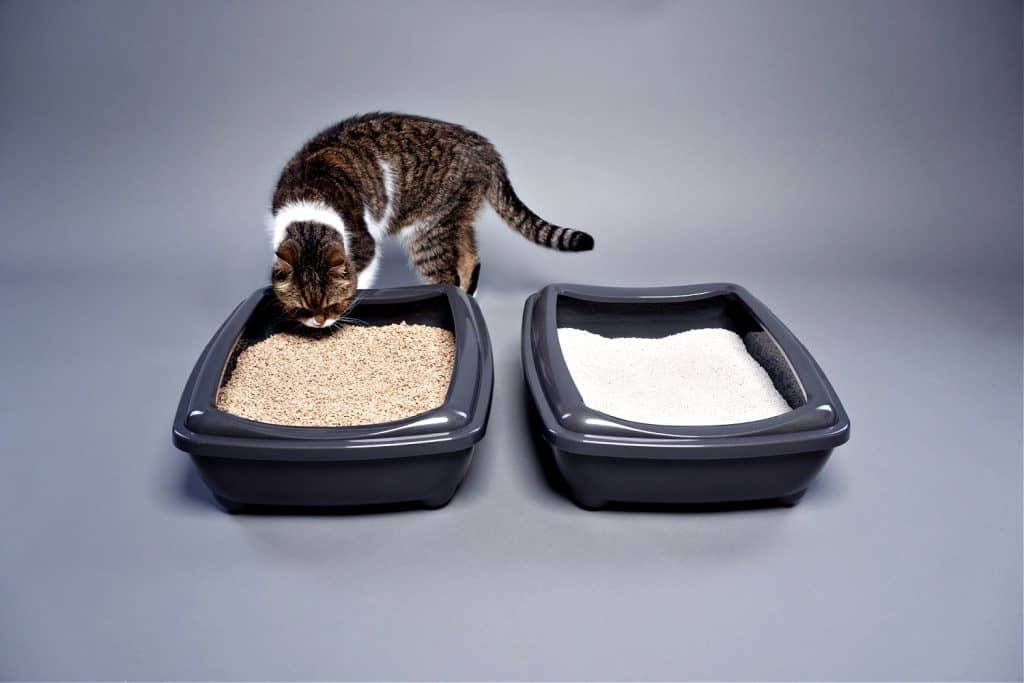
Is A Cat Litter Substitute The Right Choice For You And Your Cat?
The pros might outweigh the cons for the cat litter substitute of your choosing, depending on the method you use. Some things to consider are:
Cost Of Cat Litter Substitutes
For many pet owners, reduced price leads the list of pros. Depending on the substitute you choose, you might notice a significant drop in cat litter fees, especially if you own more than one cat.
Convenience And Ease Of Use
Depending on where you live, how accessible materials are, and how big your storage area is, you might find it more convenient to utilize a do-it-yourself cat litter alternative.
You can make kitty litter in bulk and keep it handy for future use rather than make frequent trips to the store.
Health Concerns For You And Your Cat
Many types of commercial cat litter in stores treat their formulas with chemicals. Some of these chemicals can cause health problems for your pet.
Gastrointestinal issues can occur if your cat ingests sodium bentonite clay, an ingredient used in many clumping cat litters.
Some cats develop respiratory problems from the silica dust in many kitty litters. Even humans may experience an allergic reaction to the dust.
And then, there's the issue of your own health. Read more here: Is Cat Litter Harmful to Humans?
Environmental Considerations
You may be unaware of the environmental impacts caused because of some cat litter on the market. Sodium bentonite clay obtained via an environmentally harmful strip-mining process can lead to contaminated water supplies and destroyed agricultural land and forests.
It's important to choose sustainable cat litter, whether purchased or handmade.
Furthermore, some cat litters are safer to dispose of than others. Some cat litters require disposal via landfill while other kitty litters are compostable.

Cat Litter Substitutes
By now you’ve probably realized that you can make your cats litter at home. Some cat litter methods are more complex than others. Depending on what materials you have available and how much time you want to invest in making your cat's litter, there is a wide variety of options for you to choose from.
Please understand that we're not saying any of these are better than commercial cat litter. In most cases, if you can buy high-quality litter from the store - or order it online - you'll probably be employing a better solution than any of the substitutes.
But if there are no other options available, these 10 ideas might help you out.
Homemade Cat Litter Options
1. Newspaper As A Cat Litter Substitute
This cat litter is made using shredded paper, dish soap, and baking soda. You can make this kitty litter substitute in roughly 30-45 minutes. Here’s how you can make it:
- Shred a generous amount of newspaper into small strips and fill the cat litter tray.
- Soak the shredded newspaper in warm water with dish soap until the water becomes gray and it is an oatmeal consistency.
- Drain the water. Add clean water to soak the paper again (do not add soap). Drain again.
- You might want gloves for this step! Sprinkle baking soda liberally and knead the wet paper, squeezing out the moisture.
- Spread the paper out over a screen to dry. It should be a crumbly texture.
- When completely dry it’s ready for use.
Pros: Newspaper and junk mail are readily available which makes this a handy and economical option for many pet owners.
Cons: If you do not soak the newspaper or junk mail long enough you may notice ink on your cat's paws. Others don't like the mess involved in preparation. Luckily, ready-made options are available for purchase, such as Purina Yesterday's News Unscented Paper Cat Litter.
Click Here To Check Out This Cat Litter On Amazon
2. Horse Bedding Pellets As A Cat Litter Substitute
An unusual choice, equine bedding pellets are a great alternative to cat litter. Easy to make, mix the pellets with baking soda and a bit of water. They are usually available for purchase online and in some specialty pet stores.
Click here to check out bedding pellets on Amazon.
Pros: Made from sawdust, these pellets absorb well, and are affordable.
Cons: The pellets will swell up when wet, then disintegrate into sawdust, therefore tracking outside of the box or overflow can occur. Be careful not to overfill the litter box.
3. Chicken Feed As A Cat Litter Substitute
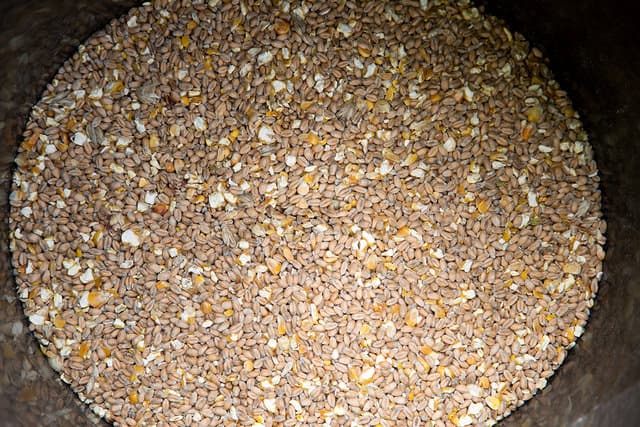
This alternative is so easy to make, mix chicken feed with baking soda for odor control. When using chicken feed as a cat litter replacement, ensure the feed has a crumbly texture and is free from chemicals and additives.
Pros: Chicken feed is a safe and affordable substitute for cat litter.
Cons: Since chicken feed is corn-based, it can become moldy and make your cat sick if they ingest it. Some pet owners may find this alternative inconvenient as it can attract rodents, you shouldn’t purchase it in bulk, and should only use fresh feed.
Ready-To-Use Alternatives
4. Wood Pellets As A Cat Litter Substitute
Hardwood and softwood pellets, designed for burning in wood stoves, are generally easy to come by. If you purchase wood pellets from hardware stores, ensure no additives are used, such as accelerants.
If you’re concerned about chemicals, you can even buy wood pellets specifically designed for cat litter use. A favorite brand among many cat owners is Feline Pine, a sustainable and chemical-free alternative.
Click here to check out Feline Pine on Amazon.
Pros: Wood pellets have excellent odor control, some smelling of pine or cedar depending on the type of pellets you choose. They also provide superior absorption, disintegrate quickly, and create minimal dust.
Cons: Oils from the wood are toxic to your pet, such as pine and cedar oils. Be sure the pellets used indicate the oils are removed during the kiln-drying process.
If you're unsure either way, contact the manufacturer if you have any questions or the store where the pellets are purchased.
5. Wood Shavings As A Cat Litter Substitute
Wood shavings and sawdust are great for absorption and, especially if you have a woodworking shop, are easily obtained. If you plan to use shavings and sawdust, use untreated wood that is chemical-free.
Pros: Both economical and biodegradable, you can compost this kitty litter in your non-edible garden.
Cons: You may notice dust and tracking of shavings outside of the litter box and wood shavings do not clump as well as commercial cat litter.
6. Alfalfa Pellets As A Cat Litter Substitute
Many pet owners commonly use Alfalfa pellets as rabbit food. These pellets absorb well and eliminate odor.
Check out these organic pellets on Amazon.
Pros: An eco-friendly option, alfalfa pellets are biodegradable.
Cons: If you overfill the cat litter pan with alfalfa pellets, you may notice increased dust and tracking.
7. Whole Wheat As A Cat Litter Substitute
Whole wheat berries can be ground into a coarse powder (or a smooth consistency if your cat prefers) and spread in your cat litter box. You can also mix in oats, depending on texture preference.
Click here to check out these hard red wheat berries on Amazon.
Pros: An environmentally friendly option, this cat litter option is compostable in a non-edible garden.
Cons: This kitty litter alternative does little to mask pet odors due to urine. sWheat Scoop offers an all-natural wheat cat litter that also provides odor control.
Click here to view the sWheat Scoop on Amazon.
8. Sand As A Cat Litter Substitute
If you’ve known anyone with a sandbox for their children, you’ve likely heard them lament that their cat loves to use it as their litter box.
Sand is easily obtained, purchased in bulk, and most times easily stored since it can be kept covered outside.
Check out this sand on Amazon.
Pros: Sand doesn’t hold pet odors and clumps well.
Cons: Unfortunately sand is easily tracked outside of the litter box. You may notice decreased tracking by using a cat litter mat.
Check out this premium cat litter mat on Amazon.
Uncommon Methods
9. Toilet Training As A Cat Litter Substitute
You read that correctly. It’s possible to toilet-train your cat!
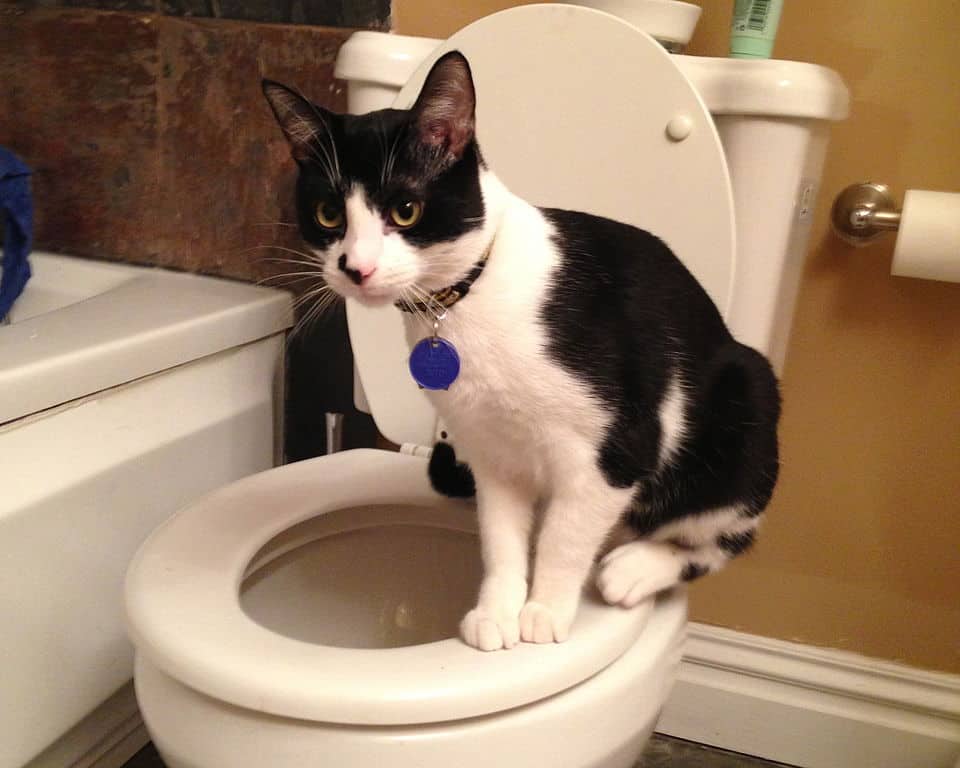
A word of warning before we describe the method. This may not be a good fit for any cat. Never force your cat to become toilet-trained. If Kitty doesn't appreciate the idea, let it go and stick to litter boxes.
Some cats find the idea of climbing on the slippery toilet bowl too abhorrent. Even if you manage to teach them, odds are down the road they'll decide your rug or bed make better bathrooms. In other words, proceed at your own risk - or skip to the next item.
With plenty of treats, patience, and a plan, you can teach your crafty kitty cat to share your bathroom facilities. You may even be able to show your cat how to flush the toilet!
Steps For Toilet Training Your Cat
If you choose to teach your cat this method, follow these steps:
- Place the litter box next to the toilet they’ll use. With this in mind, when you need to move a litter box it's important to do so gradually. Don't rush your cat and move the litter box to the bathroom gradually. Sudden changes may upset your cat.
- Place a cat training seat on top of the litter box. Allow your cat to adjust to using the seat on top of the litter box.
- Bit by bit, raise the litter box to the height of the toilet.
- When your cat is efficiently using the cat training seat on top of the litter box, consider that your sign. It's time to move the seat on top of the toilet seat.
- If your cat is hesitating or seems nervous, don't force them. Gently pet your cat to encourage bathroom use. Give your cat treats after using the litter/bathroom.
- Allow your cat roughly three weeks to adjust to this process.
Recommended Product:
There are also kits available to help facilitate this process, such as Kitty's Loo Cat Toilet Training Kit/Seat. Many cat owners say this popular product not only helped them train their cat to use the bathroom, but the company offers superb customer service as well.
Click here to see this cat toilet training seat on Amazon.
Pros: Almost zero clean-up required not including the time you will spend cleaning up any unforeseen (but expected) accidents that may occur.
Cons: If you plan on toilet training your feline, we recommend doing so when they're young. It is difficult to teach an older cat who has become accustomed to a litter box and will likely be stubborn and set in their ways.
10. Artificial Turf As A Cat Litter Substitute
It might surprise you to find artificial turf, commonly found on sports fields, on this list. It's an acceptable cat litter substitute as well as a sports green!
Not only is it aesthetically pleasing but it's easy to maintain. You can either purchase a roll of artificial grass, cut and place it into your cat litter box, or buy a ready-made mat as an alternative.
Pros: Depending on the quality you choose; artificial turf is resilient and easy to clean. Depending on the product, you can shake the excrement into the trash and rinse the artificial grass with a hose.
Cons: Some cats may disapprove of artificial grass since they are unable to scratch and hide their feces, therefore, they may destroy the turf in an attempt to do so.
Again, use with caution and never just switch from a proper litter box to this. Try offering this alternative in addition to your existing box and see if that works.
Materials To Avoid As Cat Litter Substitutes
We do not recommend using potting soil as a cat litter substitute in your home. Potting soil is incredibly messy and is easily tracked outside of the litter box. It does not clump well, and the soil holds pet odor.
If you're using any kind of wood shavings - make sure they're pet-safe AND cat-safe. Some types of wood and plant matter can be toxic for cats.
How To Transition To A Litter Substitute
Changes are stressful for most cats, no matter big or small. It’s essential to make any changes gradual and subtle. If you’d like to try transitioning to a cat litter substitute, you have two options.
Your first option is to mix one part of the substitute with three parts of their current cat litter. Over five days, you can gradually increase the ratio of cat litter substitute.
Another option is to place a second litter box next to their current litter box. Fill the second litter box with the cat litter alternative. Allow your cat time to explore both litter boxes.
This option is handy if your cat is already displaying behaviors that indicate they don’t like their current litter. If you notice your cat relieving themselves outside of the litter box or using their current litter box as quickly as they can, they may be ready for a change.
Whichever cat litter or cat litter substitute you choose, be sure to make the change slowly. A sudden change in routine or environment is upsetting for most cats. Do your pet a favor and consider their preferences before making any changes to their litter box.
Besides, for some cats, it’s more than just about a bathroom but a sense of security as well.
Have you tried any of the substitutes described here? What did you think? Or maybe you can share a new idea that we haven't listed? Leave a comment and let us know.
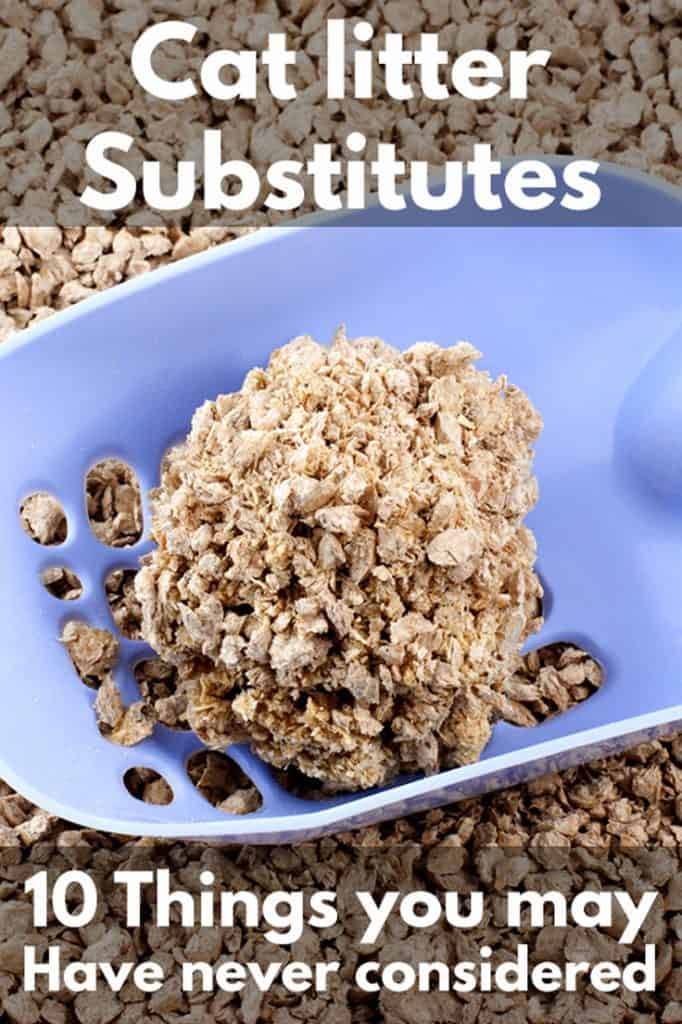










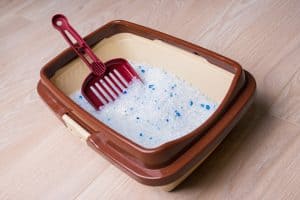
![cat examines kitty litter box with eco-friendly silicate litter - Can You Wash and Reuse Crystal Cat Litter? [Answered]](https://litter-boxes.com/wp-content/uploads/2023/08/cat-examines-kitty-litter-box-with-eco-friendly-silicate-litter-300x200.jpg)
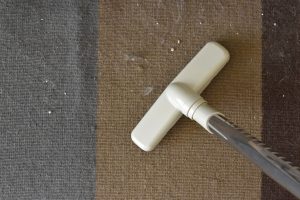
My cat is eating clumping kitty litter. What is a good replacement?
Hi Freddie,
You should talk to your vet first. When a cat munches on litter, it may be an indication for some deficiencies in his/her diet.
We rescued a stray kitten, about 6 or 8 weeks old. We have decided to keep her and give her a wonderful home. That being said, she will not use the litter box. It is like her feet are being soaked in acid. So I have mixed potting soil into the litter and she urinates and sometimes defecates in it…..any ideas? We love her already, as do our dogs, but we also love our home….
Hi Penni,
You should probably try other types of litter with this kitty. Try corn-based or similarly soft litters and see if this helps. It might be worth trying a different kind of litter box too, in addition to the current one. Also, give her time, she’s very young and may be missing the box because it’s too far away from her. You can always also ask for advice over at the forums at TheCatSite.com – good luck!
my kitten has green guu in his eyes
i just got a kitten and he has green stuff in his eyes
I just rescued a kitty and I don’t have any baking soda or anything else that could be used as a substitute. I have about another week until I can afford to get some litter. What should I do?